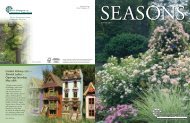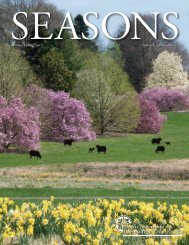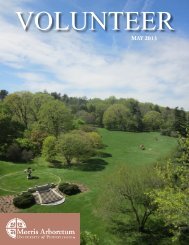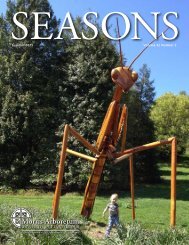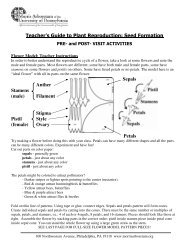2010 - Business Services - University of Pennsylvania
2010 - Business Services - University of Pennsylvania
2010 - Business Services - University of Pennsylvania
Create successful ePaper yourself
Turn your PDF publications into a flip-book with our unique Google optimized e-Paper software.
Conservation Corner<br />
kIM FrISbIe – Freelance Writer & Arboretum Directors’ Guild Co-Chair<br />
In the last issue <strong>of</strong> Seasons I talked about the importance<br />
<strong>of</strong> reintroducing native plants to our gardens in order<br />
to maintain insect populations in our local ecosystems,<br />
thereby providing food sources for the native wildlife that live<br />
here. Specific plants can pr<strong>of</strong>oundly change our environment.<br />
The Norway maple (acer platinoides), was introduced by John<br />
Bartram from Northern Europe in 1756, and is now one <strong>of</strong><br />
the most common shade trees in North America. When it<br />
first arrived, this species had never interacted with the plants,<br />
animals or pathogens <strong>of</strong> North America. Now, some 250 years<br />
later, it is no surprise that it has still not adapted to the needs<br />
<strong>of</strong> the plants and animals <strong>of</strong> our country. The Norway maple<br />
throws such dense shade that nothing at all can grow beneath<br />
it, producing a monoculture in many woodlots. Native insects<br />
cannot ingest its foliage, and its winged seeds are carried easily<br />
by the wind, thus dispersing it effortlessly.<br />
Another example <strong>of</strong> a deadly invasive alien is Oriental<br />
bittersweet (Celastrus orbiculatus). This aggressive vine was<br />
imported as an ornamental in the 1860s because <strong>of</strong> the<br />
showy red arils that cover its yellow seeds, making it popular<br />
in flower arrangements. Today, bittersweet is found from<br />
Maine to Georgia, and west to Missouri. Once established,<br />
it destroys every plant it comes in contact with, girdling the<br />
trunks <strong>of</strong> trees it climbs upon, <strong>of</strong>ten bringing down much<br />
larger trees by its sheer weight. Growing faster than its native<br />
counterparts, bittersweet quickly reaches the canopy <strong>of</strong><br />
The Eastern redbud (Cercis Canadensis)<br />
is just one <strong>of</strong> many beautiful native trees.<br />
the tallest forest trees, but it is even more deadly to young<br />
saplings which are quickly smothered by its vines. Mile-aminute<br />
weed (Persicaria perfoliata) and Japanese knotweed<br />
(Fallopia japonica) are two other invasive species with which<br />
many <strong>of</strong> us have come in contact. Both <strong>of</strong> these grow faster<br />
than native species, effectively smothering all other vegetation<br />
by forming dense mats and thickets through which nothing<br />
else can grow. Both are extremely difficult to kill, and by<br />
forming monocultures, they exclude the valuable native<br />
plants that are so necessary to local wildlife.<br />
By favoring native plants over alien species, we as gardeners<br />
can help sustain the biodiversity that is essential to balanced,<br />
functioning ecosystems. Yes, our plants may not always have<br />
perfect foliage; there will be some insect damage, but that is<br />
just evidence that our gardens are not sterile, but full <strong>of</strong> life.<br />
Insect herbivores are kept in check by dozens <strong>of</strong> species <strong>of</strong><br />
insect predators and parasites. These are eaten daily by the<br />
birds, amphibians and small mammals in the area. Insects are<br />
also decomposers, playing another vital role in recycling the<br />
nutrients in dead plants and animals for later use further up<br />
the food chain. In a balanced community, no one member<br />
dominates – thus, in a native forest, you may notice that<br />
individual leaves may show some insect damage, but not<br />
enough to harm the plant, and the result is a garden that<br />
while not perfect, presents itself as one <strong>of</strong> health, beauty<br />
and balance.<br />
S e a S o n S S P R I N G 2 0 1 0 | 12




